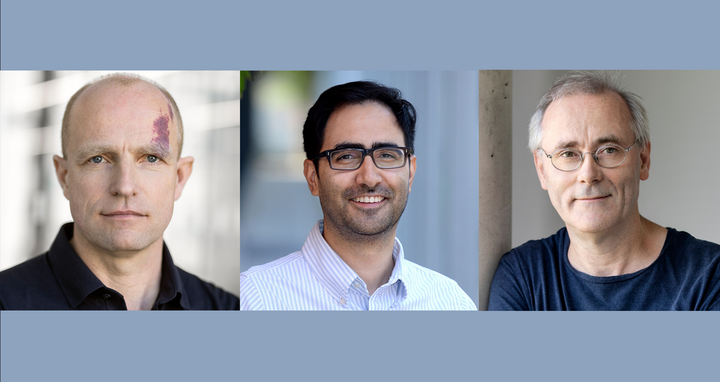Long awaited by the pharma industry
When new products or technologies leave the laboratory to prove themselves in practice, it is a matter of all or nothing. The outcome of the validation process determines whether a new therapeutic agent or an innovative method will, or will not, actually be used in patient care in the future. Scientists not only test whether the therapeutic agent or the method is clinically suitable for the intended diagnosis or therapy, but also whether it sufficiently reliable and safe and capable of being produced outside the laboratory.
In this critical phase, the Helmholtz Association supports researchers with grants from its Initiative and Networking Fund. This year, among those winning grants are three teams from the Max Delbrück Center: the RNA Biology and Posttranscriptional Regulation Lab headed by Professor Markus Landthaler, the Molecular Physiology of Somatic Sensation Lab headed by Professor Gary Lewin, and the Bioinformatics and Omics Data Science Platform headed by Dr. Altuna Akalin.
Boosting protein production in cells
Markus Landthaler has developed a method that could take the production of therapeutic proteins to a whole new level. Such proteins, which are used to treat serious diseases like cancer, rheumatism, and multiple sclerosis, are often manufactured from genetically engineered mammalian cells. The mostly widely used mammalian cells are Chinese hamster ovary (CHO) cells, which is an immortalized cell line derived from the ovaries of the Chinese hamster.
CHO cells produce therapeutic proteins very reliably, but the production process is complex and expensive. Costs would be significantly lower if higher yields could be obtained. Landthaler and his team have succeeded in engineering CHO cells to produce more proteins. “The pharmaceutical industry has been waiting for this for a long time,” says Dr. Daniel Romaker, an innovation and technology manager in the Technology Transfer Office who is helping to shepherd the project. Last year, the Max Delbrück Center filed a patent for this technology.
Now Landthaler is about to carry out validation testing. The researcher will receive €300,000 in funding from the Helmholtz Association over the next two years. He and his colleagues are currently looking for a company to test the optimized CHO cells under industrial conditions. They want to find out whether these cells act just as reliably in bioreactors with volumes of 5, 10, or even 1,000 liters as they do in the laboratory petri dish. In addition, Landthaler seeks to show that the method is suitable for producing antibodies. If he succeeds in doing this, he shouldn’t have any trouble finding investors to finance a spin-off.
Turning off the pain
New pain drugs often fail in phase I and II clinical trials, so investors shy away from this market.
Professor Gary Lewin also wants to use his grant – worth €800,000 over two years – to win over investors to his idea. He is interested in advancing a drug-based pain therapy. “New pain drugs often fail in phase I and II clinical trials,” says the scientist, “so investors shy away from this market – even though there is a huge demand for such drugs.” That makes it all the more important that validation is absolutely airtight.
Lewin’s team has developed a molecule that reduces nerve pain, also called neuropathic pain. This pain occurs when the “sensory fibers” of the nervous system are damaged, such as by autoimmune diseases like multiple sclerosis or by diabetes, alcohol abuse, infection, or injury. Unlike “normal” pain, the pain impulses do not usually originate in the region of the nerve endings. They are instead caused by ion channel activation in the tactile and pain receptors of the skin. The sensitivity of these ion channels is controlled by stomatin-like protein 3 (STOML3). “As early as 2017, we were able to show in a mouse model that pain sensitivity decreases when STOML3 is inhibited,” says Lewin.
Now his team wants to demonstrate that the inhibitor also works in human neurons. To do so, the researchers are collaborating closely with labs in Australia and the United Kingdom. They also plan to hire a medicinal chemistry company in the Netherlands to further improve the therapeutic agent’s effectiveness. “We want to introduce the main molecule into the cells as stably as possible,” explains Lewin. “Our goal is to improve it to such an extent that after taking one tablet, the effect lasts for a whole day.” Such an advance would be a great relief for patients suffering from nerve pain.
AI assists with drug development
Artificial intelligence can help shorten the development time and thus lower drug prices.
Developing a new drug is a lengthy process. It is not uncommon for it to take 10 to 15 years to find and test a new therapeutic agent. The costs can run up to several billion euros. “This especially explains why innovative cancer drugs fetch such high prices,” says Dr. Altuna Akalin. “Artificial intelligence can help shorten the development time and thus lower drug prices.” The bioinformatician will receive €800,000 over the next two years from the Helmholtz Initiative and Networking Fund to develop an AI-enabled drug discovery platform. He has been working on the computational genomics and applied machine learning for 20 years. In 2017, he and his team succeeded in using artificial intelligence to find biomarkers for several types of cancer.
The AI system he is currently creating aims to cover three stages in the development of new therapeutics: The first step consists of identifying genes and proteins that are suitable targets for drug therapy. The system then focuses on finding molecules that can inhibit disease-causing processes. Lastly, the AI uses biomarkers to track down patients for whom this therapy would be effective. Over the course of the project, Akalin will test all three stages and then experimentally evaluate the AI’s predictions.
“Cancer research methods are very data hungry,” says Akalin, “so we have a vast amount of data with which to train our system.” He is initially focusing on colorectal cancer and neuroblastoma, but says the system can be adapted to other cancers as well.
Text: Jana Ehrhardt-Joswig








